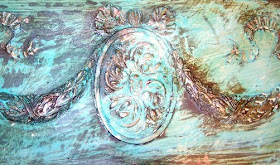Gleaning the Fields and Artist Studio Tour.
Growing up in East Germany, food was hard to come by. I lived in a small farming community, as I do now, only now, Worlds Apart.
As a very young girl I would offer my services to farmers. It was usually a job that involved food of one kind or another. In the winter I would cut up hot fatty pigs meat into little squares to be used for sausages. In the summer I thinned rows upon rows of sugar beets. My pay; a sandwich and a cup of hot beef broth.
I don't know how my mother always knew when certain fields were being harvested. We were allowed to Glean the Fields. We gleaned what the machines left behind. That could be potatoes, beets and all sorts of grains.
To this day I can not ignore an unclaimed fruit tree that is laden with fruit. And now my own orchard has matured. That means that a lot of canning takes place in my kitchen in September.
Speaking of my kitchen, that is also where I paint my ceramics. That is where my "Artist Studio" is located. In a corner, by a large window, where I can see my pond, where I can keep an eye on my cooking and baking and where I can do my laundry.
Every September visitors from the 'big city" come to the "Artist Studio Tour" event. Many artists reside in our little town of 500 residents. My "Studio" is also open to visitors.
Besides selling my ceramics, I have also been asked to sell my canned goods, which is a good thing because I have been way too busy in my kitchen. My customers tell me that it is the labels. The images are from my painted ceramics, they make colorful and unusual labels.

A year later, they come back for the ceramics, the labels and what is in the jars.

My kitchen. Way in the back, by the large window, is my "Artist Studio"
Gina
 It is my first crop of plums from our young tree, I couldn't let them go to waste. The Pflaumenmuss baked all night, now in glasses and labels affixed early this morning.
It is my first crop of plums from our young tree, I couldn't let them go to waste. The Pflaumenmuss baked all night, now in glasses and labels affixed early this morning. There is a certain fig tree in a vineyard, between Florence and Sienna, a perfect shelter for a picnic and the figs, the perfect dessert.
There is a certain fig tree in a vineyard, between Florence and Sienna, a perfect shelter for a picnic and the figs, the perfect dessert. 
































